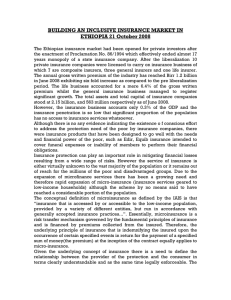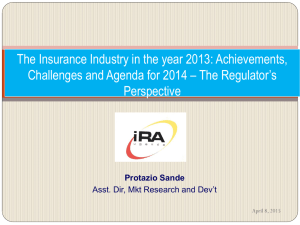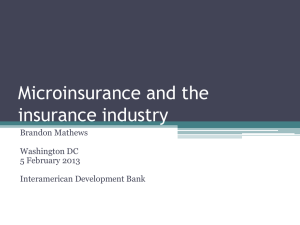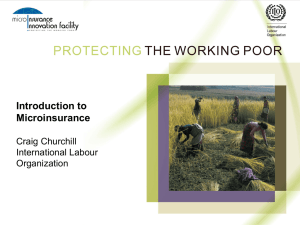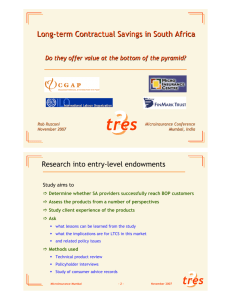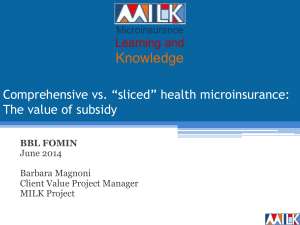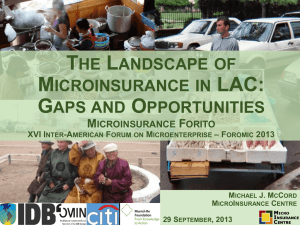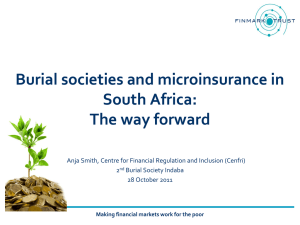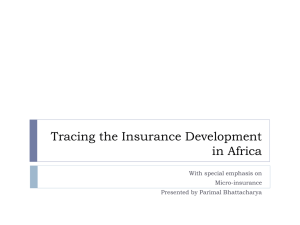Mapping Microinsurance in Bangladesh_revised
advertisement
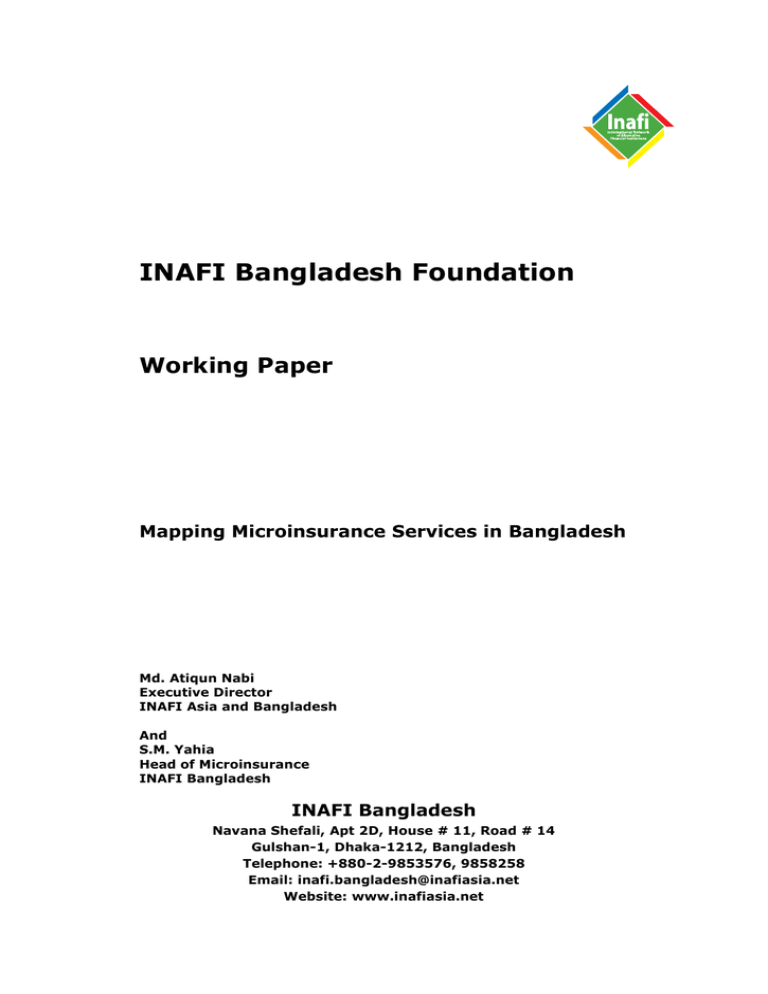
INAFI Bangladesh Foundation Working Paper Mapping Microinsurance Services in Bangladesh Md. Atiqun Nabi Executive Director INAFI Asia and Bangladesh And S.M. Yahia Head of Microinsurance INAFI Bangladesh INAFI Bangladesh Navana Shefali, Apt 2D, House # 11, Road # 14 Gulshan-1, Dhaka-1212, Bangladesh Telephone: +880-2-9853576, 9858258 Email: inafi.bangladesh@inafiasia.net Website: www.inafiasia.net 1. Introduction Insurance functions on the concept of risk pooling, and likewise, regardless of its small unit size and its activities at the level of single communities, so does microinsurance. Microinsurance links multiple small units into larger structures, creating networks that enhance both insurance functions (through broader risk pools) and support structures for improved governance (i.e. training, data banks, research facilities, access to reinsurance etc.). This mechanism is conceived as an autonomous enterprise, independent of permanent external financial lifelines, and its main objective is to pool both risks and resources of whole groups for the purpose of providing social and financial protection to all members against the financial consequences of mutually determined risks. The term ‘microinsurance’ refers to the products and services that ensure social security of the poor and low income group by reducing risk and vulnerabilities in case of sudden death, health hazards, loss of asset and future planning for the old-age. Micro-insurance fills many financial gaps ensuring social protection. They are financial gaps of immediacy, such as expenses related to a funeral event (e.g. the coffin and catering); financial gaps that are related to the culture of the deceased (e.g. repatriation, and the unveiling of the headstone); and the longer term survival gaps for dependents, such as schooling and expenses associated with housing, health coverage in case of sickness, hospitalization and income eroded due to illness and restoration of livelihood in case of loss of assets and crops. 2. State of Microinsurance: Growth and status of Microinsurance Sector in Bangladesh According to Marc Socquet of the International Labour Office, 93% of the population of Bangladesh is excluded from any insurance protection. Sigma Report 2006 states Insurance penetration in Bangladesh at 0.9% which is one of the lowest in the world. Michael McCord, one of the leading microinsurance experts, reports in The Landscape of Microinsurance in 100 Poorest Countries, “only 6.5 million poor people in Bangladesh have any insurance coverage”. These statements and statistics sum up the insurance scenario for the poor in Bangladesh.1 Microinsurance is still a comparatively new concept but becoming increasingly popular day by day. Microinsurance is, however, still being considered as informal insurance and mostly being offered by microfinance institutions (MFIs). The Delta Life Insurance is the first private regulated insurance company in Bangladesh that entered in the Microinsurance in 1988, inspired by the growing success of the Grameen Bank and other Microcredit schemes in Bangladesh. Delta launched an experiment of its own, Grameen Bima or village insurance. Initially, the design for Grameen Bima called for collaboration with a Microcredit NGO that provided the delivery structure for Delta’s endowment product. This partnership dissolved after a short time because of a difference in objectives (Michael J. McCord. 2005). With the tremendous success of Delta Life Insurance, some MFIs/NGOs as well as private insurance companies came forward to offer Microinsurance products to the poor people. The MFIs/NGOs came forward with health insurance and also loan insurance to protect their portfolio and reduce portfolio at risks. Bangladeshi microfinance NGOs came into the Microinsurance scene in the late 1990s and early 2000s. Currently Microinsurance is being offered by both mainstream insurance companies and MFIs, though in small scale. 94 NGOs/MFIs and Grameen Bank are also offering Microinsurance products to the low-income group. 1 Ahmed, Mosleh Uddin, Feasibility Study on Workplace Micro-Insurance in Asia: Country Report-Bangladesh, p. 18 The organizations’ Microinsurance practice is informal as they are not registered under the Insurance Authority and therefore not governed by the insurance law. However, they cover much larger population than the mainstream insurance companies do. Almost all the MFIs/NGOs offer loan insurance and life insurance to their member organizations. The risk of normal death and accidental deaths are mostly covered by the insurance. The life insurance products offered by the NGOs/MFIs, including ASA, BRAC and Grameen Bank, are very simple. They cover the outstanding loan balance and in provide an additional one-time payment to the beneficiary. On average the one-time payment amounts to BDT 5000 (USD 72.5). They are mainly designed to protect the organizations’ loan portfolio rather than protect the poor household. No products are available where the sum assured represents ‘value of lost earnings due to death’.2 The term of life insurance products of NGOs/MFIs is one year. As the insurance is tied to loan, the premium is collected during loan disbursement and hence there is no additional distribution cost associated with the insurance. Premium is on average 5-10% per loan amount. The amount deposited is non-refundable. The only exception is BRAC that offers a death benefit to its beneficiary without collecting any premium. At present 16 mainstream insurance companies are offering Microinsurance products licensed and regulated by the Insurance Law. All insurance companies only offer life Microinsurance products that cover normal death of the policyholder. For mainstream insurance companies, the life insurance schemes are voluntary whereas that of most NGOs/MFIs is mandatory. The term of their life insurance varies from 10 to 30 years. At the time of maturity the insurance companies usually pay a percentage of profit as bonus additional to the sum insured. Premium can be as low as BDT 100 per monthly. Though mode of payment can be monthly, quarterly or annually, most commercial insurers collect premium annually so as to minimize their operational expenses. Most insurance companies make partial payment of the sum insured twice or thrice depending on their policy during the term of the insurance scheme. A policyholder can surrender his/her policy after 3 years. However, the payment is refunded only at the initial time of maturity. In spite of high demand for health insurance, only a few NGOs are offering health Microinsurance to the poor. The main concern regarding health insurance is its sustainability. It has been argued that health insurance can be cost-effective only when it is made mandatory. Most health insurance products are on a co-payment basis. They all cover hospitalization costs. Some also cover outpatient services, emergencies and pathology. Some NGOs have their own health care facility from where health service is provided as part of the insurance claim. 3 Asset Microinsurance is not so popular among the NGOs/MFIs. Main reason behind is this is that there is possibility of moral hazard in the absence of proper monitoring. A very few NGOs those who do offer asset insurance such as livestock insurance have their own livestock programme which makes monitoring easier. Microinsurance products may generally be divided into: life Microinsurance, health Microinsurance, disability Microinsurance, property Microinsurance, and crop Microinsurance. There are other kinds of Microinsurance products but they are not usually marketed by the insurance providers due to the low demand by the prospective beneficiaries. In Bangladesh, Microinsurance is offered by the commercial insurers (formal sector) as well as Micro-finance institutions (MFIs). Formal Microinsurance Sector in Bangladesh Formal microinsurance sector is defined as the microinsurance schemes which are offered by the insurance companies licensed by the insurance regulatory authority under the relevant provisions of the insurance laws. The first product introduced by a life insurance company in the late 1980s was a saving plan linked to the insurance coverage and was aimed at the low income people living in rural areas. Premiums were small and collected from door to door in weekly installments. Other plans, namely, small saving plan, home saving 2 Ahsan and Hakim (2010), Design of Microinsurance Products, InM Microinsurance Team Al Hasan, Rashed (2005), Reducing Vulnerability of the Poor through Social Security Products-A Market Survey on Microinsurance in Bangladesh, INAFI Bangladesh Research Paper, 3 insurance plan, child welfare insurance plan, female child education insurance plan and five plus insurance plan were introduced within a short period of time under the same project. The company introduced another set of Microinsurance products under a different project based on the same concept of the project introduced earlier but was aimed at the urban low-income group living in the slum areas in cities and towns. Premiums would be collected from door to door in monthly installments. Microinsurance products introduced under this project were: Saving insurance plan, saving insurance plan (modified), advance payment endowment plan, and two installment insurance plans. The model of credit program introduced by Grameen Bank was replicated by the company for loan program under the Microinsurance projects. In the case of Grameen Bank, loans would be given to the members of Grameen Bank, whereas loans under Microinsurance projects would be made available to policyholders. Although the credit program was an integral part of the projects, it was not the intention of the insurance company to sell policies on promise of credit. A policyholder could not ask for credit as a matter of right. Each project was supposed to be judged on its merit and the money would be advanced only when the project would be judged viable. The distinction of policy loan and the project loan was that policy loan would be advanced against the security of an insurance policy, while the project loan would be given in consideration of the viability of the project. Microinsurance products under the two projects were, however, discontinued and a new set of Microinsurance products were introduced. Growth of sales of new microinsurance products also continued to grow mainly because of lower rates of premium. Encouraged by the phenomenal growth of microinsurance business launched by the company almost all life insurance companies introduced similar microinsurance products. A few companies market the same products under different projects to promote competition among the sales executives in an effort to increase policy sales. In a few cases same products are assigned different titles and codes. One of the two popular products introduced by the insurers is the ordinary life insurance endowment plan and the other is anticipated endowment plan, which is similar to ordinary Endowment but the survival benefit is payable at periodic. Delta Life Insurance Company is the pioneer of Microinsurance service provider in the formal sector in Bangladesh. Delta has 1.2 million clients. Health Insurance: In Bangladesh, a few Insurance companies are offering Health Microinsurance to the low in income people, like Green Delta General Insurance Company. This type of health insurance provides coverage for illness and accidents arising from physical injuries. Health insurance usually provides coverage for limited hospitalization benefits for certain illnesses, and for costs of physicians and medicine Agricultural Insurance: Shadharan Bima Corporation (SBC), the state owned non-life insurance organization introduced a Crop Insurance Scheme in 1977 and then a Livestock (cattle) insurance Scheme in 1981 on a pilot scheme basis under the initiative and directive of the Government of the People Republic of Bangladesh. The major purpose of the project was to develop appropriate and low-cost models of crop insurance for subsequent replication and expansion. In these schemes SBC provided coverage against the wider range of climatic perils, including floods, cyclone, drought and biological perils, pest and diseases. The pilot program started on voluntary basis for rice (Aman, Boro and Aus), wheat, sugarcane, and jute etc. The sum insured was set at 80% at the past three year average yield for each crop on each farm and valued at the govt. Intervention price of the crop. Premium rates were calculated on an actuarial basis, but farmers were not able to pay the premium and hence considering their financial position premium rates were fixed at 3% for jute and wheat, 4% for Aus paddy and 5% for Aman paddy and sugarcane. Loss adjustment was calculated based primarily on ``eye estimation`` techniques. The crop insurance program of SBC was continued for 19 years on a voluntary basis. During this period the program incurred major underwriting losses to the extent of Tk. 19,768,802,84 against the premium of Tk. 3,962,337.15 with the claim ratio 498.87%. On the other hand, in 1981 Cattle & Livestock insurance was introduced, thought offered in a large scale, had a favorable claim ratio of 56%. In the year 2003 the Government further felt the necessity to start crop insurance and as such Sadharan Bima Corporation submitted a specific concept paper on this scheme. This Concept paper was under consideration of the govt. of the People Republic of Bangladesh. A number of Meeting and discussion were held. Eventually, in the year of 2010 Govt. has taken-up the initiative to reintroduce Crop Insurance in the shape of Pilot scheme in the specific area for gathering another experience. Recently SBC has introduced Crop insurance Crop insurance at Madhobpur Upazilla under Hobiganj District. Asset Insurance: Property insurance provides coverage against loss or damage of asserts. It is very difficult for an insurance provider to offer property microinsurance because of the need to verify the extent of damage and determine whether loss has actually occurred. There is a great deal of moral hazard attached to this kind of insurance. However, insurance as well as MFIs in some countries provide insurance coverage against damage to property and other kinds of assets to low income segment of the population at affordable prices. Non-life commercial insurance in Bangladesh has started providing fire insurance coverage against damage to business properties of micro entrepreneurs. 3. Regulatory Aspects of Microinsurance in Bangladesh There was no specific provision for regulation of Microinsurance business in the Insurance Act, 1938. While a very liberal insurance legislation can give rise to massive expansion of insurance services eroding the long term viability of the insurers, a very rigid legislation can restrict the growth of microinsurance business. In the absence of appropriate legal infrastructure the interests of policy holders cannot be adequately protected. The Government of Bangladesh has enacted Insurance Act, 2010 and repealed the Insurance Act, 1938. The Insurance Act 2010 has established Insurance Development and Regulatory Authority (IDRA) who has been assigned as regulatory and supervisory body for the insurance sector as a whole, under the Ministry of Finance, Government of Bangladesh. The IDRA has been constituted with 5 members headed by a Chairman appointed by the Government. The Insurance Act, 2010 provides that every insurer shall, after the commencement of the Act, undertake such percentages of life insurance business and non-life insurance business in the rural and social sectors as may be specified in the official gazette by the Authority. Recently, IDRA has prepared rules and regulations and published it through the gazette notification. This rules and regulation have not mentioned ‘Microinsurance’ as a subsector or separate product line. It has specified a regulation requiring the insurers to undertake a minimum percentage of insurance business in rural and social sectors. These regulations would probably be the starting point and IDRA may consider issuing further notifications supplementing the regulations for orderly growth of microinsurance business in Bangladesh. The recently issued notification/circular issued by IDRA specifies commission rates and other forms of remuneration payable to insurance agents and employers of agents for acquisition of life insurance business. These rates are equally applicable to microinsurance business. The IDRA has also issued a notification/circular for giving license as life and non life Insurance company. In the Insurance Act, 2010 there is provision for establishing Mutual Insurance Company. Here mentioned that policyholders will be owner of the Mutual Insurance Company. But till now, IDRA has not developed specific policy guidelines for Mutual Insurance Company. IDRA has to come up with rules and regulation for Mutual Insurance Company separately. Microfinance Institutions in Bangladesh has been regulated by the Microcredit Regulatory Authority (MRA), , established in 2006 , through passing a act in the parliament titled as “Microcredit Regulatory Act 2006” which is the sole authority to issue license for operating microfinance and as well as regulatory and supervisory body for Microfinance Institutions (MFIs) . The MRA has also formulated “Microcredit Regulatory Authority rules and regulations, 2010 which has been enacted from July 2011, has approved that MFIs can offer Microinsurance services for its borrowers and members of the family members, being licensed by MRA to operate Microcredit services. Therefore, Microfinance institutions who have been licensed by MRA can offer Microinsurance services to the borrowers and members of the borrowers’ family. But MFIs have to inform MRA and need to seek permission from MRA by giving product description, mode of operations and submit periodical financial reports related to Microinsurance services 4. Microinsurance Products Offered by MFIs/NGOs Most of the large MFIs/NGOs in Bangladesh offer a variety of microinsurance products to their clients. These MFIs/NGOs had several thousand clients, strong information-tracking capabilities through their large network of branches throughout the country, and a stable saving and credit portfolio before they developed insurance product on their own. Insurance coverage reduced the vulnerability of their clients against unforeseen risks on the one hand and enabled the MF-NGOs to run their credit programs without undertaking undue risks of loan default due to death of the borrowers, on the other. Important players in the non-formal sector microinsurance market are BRAC, Grameen Kalyan, ASA, Proshika, Gonoshastho Kendra, Sajida Foundation, Shakti, Dhaka Community Hospital, Nari Uddyog Kendra, Dushtha Shastha Kendra, Integrated Sevelopment Foundation (IDF) Padakhep, Society for Social Services, INM and INAFI Bangladesh. Typically these MFis/NGOs form groups of village poor, encourage the groups to make small weekly savings, supplement these savings with MFIs-NGOs’ own funds and arrange disbursement through the groups to pursue different forms of income generating activities. The borrowers are required to repay the loan in small installment at short intervals, usually on weekly basis. Microinsurance products offered by MFI/NGOs in Bangladesh cover the outstanding loan balance, health, disability and provide, in some cases, an additional one-time monetary benefit to the client’s designated beneficiary. Some of these MFIs/NGOs appeared in the microinsurance scene in the late 1990s, while others in late 1990s and thereafter except Gonoshashtho Kendro, which developed health microinsurance product in 1978. Microinsurance tends to be more expensive than the traditional insurance offered to high income or middle class people due primary to high transaction costs. But in the case of microinsurance products offered by MFIs/NGOs in Bangladesh, marketing cost is very small. The product design is very simple. Microinsurance products offered by MF-NGOs Bangladesh cover the outstanding loan balance, health, disability and provide, in some cases, an additional one-time monetary benefit to the client’s designated beneficiary. Some of these MFIs/NGOs appeared in the microinsurance scene in the late 1990s, while others in late 1990s and thereafter except Gono Shashtho Kendro, which developed health microinsurance product in 1978. Grameen Kalyan, a subsidiary of Grameen Bank, started providing curative and preventive health insurance services in 1996. GK received an Endowment Fund from its parent organization to generate income for the scheme and meet any shortfall in the operating expenses. GK’s premium rates do not seem to be based on actuarial calculations; rather it was established through a process of trial and error and consultation. Grameen Bank has two insurance schemes for its members, namely, loan insurance and life insurance. Under the loan insurance scheme, in case of death of a borrower all outstanding loans are paid off from the insurance fund. Insurance fund is created by the interest generated through annual deposits in the saving account of the borrower. Borrowers are required to put an amount equal to a certain percentage of the loan amount each time in a designated saving account. If her/ his loan amount does not exceed the amount in the previous year, she/he does not have to add any more money into this account. If it exceeds, then she/he pays a certain percentage of the incremental loan amount. In the case of life insurance, each family receives a specified amount against the death of the borrower. Borrowers are not required to pay any premium. They come under insurance coverage by being a shareholder of the bank. The SSS health program was introduced in 1996 with donations from SSS staff Bangladeshi philanthropists. ASA provides insurance facilities for its group member and also members’ husband/guardian. Main microinsurance products offered by ASA are loan insurance and life insurance. In the case of loan insurance all clients must contribute and participate in the product by paying a foxed premium in each loan cycle. Premium in each loan cycle is Tk 10 (for loanee and his /her spouse or guardian) per thousand loan disbursement. Premium is non-refundable but in the case of death of borrower or borrower’s spouse the total outstanding loan is written off. In the case of life insurance clients pay Tk. 10 per week or Tk. 50 per month as insurance premium. Premium is refundable with 4% interest but 6 times the amount of balance paid in case of clients’ death. Term of the policy is 400 weeks or 8 years. No. of clients under this product is 4.7 million. We could not verify whether premium rates sound and advantageous. We could not also ascertain whether the fund accumulated up to balance sheet date is adequate to meet the liabilities as on the same date. ASA also maintains insurance for each of its staff without taking premiums from them. ASA also maintains a fund for its clients for their costly medical treatment. Members do not have to pay any premium to get this assistance. In 2006, Sajida Foundation established a comprehensive microinsurance program called HELP to provide social protection and security to its members and their families. Since its inception, the microinsurance product has undergone much change. One of the major developments is that the health insurance program has increased coverage to almost 100% of Sajida and widened the scope of health services to include health awareness, prevention, basic and secondary curative care. A recent development of the microinsurance program includes a change in the name from HELP to Nirapatta (meaning safety). Nirapatta has 5 components, namely, education, life/loan, legal and main-made disaster. No. of households are covered 119,565 under this scheme. BRAC formally introduced health microinsurance for poor women in Bangladesh in 2001 when a 3-year financial and technical assistance agreement was signed with the ILO’s Women Empowerment through Employment and Health. BRAC started offering health insurance with three insurance products: an annual general package, a package at pregnant women, and a product targeted at school children. PADAKHEP introduced microinsurance product for its borrower members under its holistic Microinsurance Program in 1999. This insurance scheme covers 10 different risks, the most important of which is credit life insurance. A borrower member has to deposit 1 percent of the outstanding loan amount as insurance premium. Loan insurance, sometimes called credit life insurance, usually provides cover for outstanding installments in the event of death of the borrowers. For example, if a borrower dies during the term of insurance payment of outstanding installments is exempted. There are variations of benefits under this scheme but such cases are very rare, and cannot be termed as credit life insurance in the true sense of the term. Life insurance cover provided by these organization is in the form of term insurance where a fixed sum or a variable sum of money is payable to the designated beneficiary on the death of the life assured. Endowment type life coverage where premium deposited are returned with or without interest is also provided in a very few cases. In most of the cases under the health insurance scheme hospitalization costs with a maximum ceiling are covered. In the cases of livestock insurance the outstanding loan is exempted if the cow dies or there is any epidemic in poultry. In most of the cases the deposited premium are not refunded, but some organizations refund the deposited premiums, if there is no claim within the specified period. Since most of these insurance products are based on risk pooling. A review of life micro insurance products introduced by some of the MFIs/NGOs show that they are of ordinary endowment type insurance products requiring setting up reserves against the long term policy liabilities. Microinsurance products introduced by some of the MFIs/NGOs show that they are of ordinary endowment type insurance products requiring setting up reserves against the long term policy liabilities. It is not clear whether such reserves have been set up by these MF/NGOs. 5. INAFI Members’ Microinsurance Program INAFI Bangladesh has 30 NGOs/MFIs as its members. Among the MFIs offering microinsurance services, ASA, Brac, SSS, Sajida Foundation and PADAKHEP are member organisations (MOs) of INAFI. Apart from the individual microinsurance program of the MOs, INAFI Bangladesh is offering life and health microinsurance products to the low-income group through 13 of its MOs. 6. Major Challenges Major challenges faced by a few life insurers are: I. Low persistency II. High management expenses III Low rate of return on investment Major challenges faced by MFIs/NGOs are: I. Lack of expertise II. Operating without legal coverage III. It is not clear whether product pricing and reserving are done in a proper manner. Suggestions for Improvement of Microinsurance Services The authorities may consider initiating following lines of action: I. Separate remuneration package for agents and employers of agents as has been introduced in some jurisdictions II. Introduction of partner-agent model III. Introducing, on a pilot scheme basis, bancassurance IV. Specifying regulations for investment of microinsurance fund V. Introducing corporate agency system 7. MIME-A Mutual Microinsurance Initiative for the Low-income Group in Bangladesh From its experience, working as network of NGOs and MFIs, INAFI Bangladesh has considered ‘microinsurnce’ as service to the poor to ensure social security, risk coverage and future planning to combat with multidimension of poverty. The concept of microinsurance has emerged as the mainstreaming insurance company has not been able to provide services to this poor and low-income group of the people currently, with the tailor-made products, building awareness through insurance education and proper institutional arrangement. MIME was born out of the need for tailor-made financial products that will serve the interest of the poor and low-income people. It is a social security project that has been implemented by INAFI Bangladesh through 13 partner NGOs. The project was initiated in May 2007 with the view to offer insurance services to the poor and low-income people, usually underserved by the mainstream insurance companies. MIME - A Social protection for the low-income group INAFI Bangladesh Foundation realized that the rural poor are vulnerable and prone to different risks. They need social protection by insurance services which are affordable to them, have easy procedures and can settle quick claims. Most of our poor people live in the rural areas, not aware about insurance services, have got negative connotation about insurance, they need to be educated and be aware of how insurance can benefit them in minimizing their risks and reducing vulnerability in their life. Tailor-made insurance products have to be developed and to make these products available at their door steps have been considered as the big challenge for the inclusion of the poor in the insurance services. These facts and situation have lead INAFI Bangladesh Foundation to think establishing a specialized microinsurance company for the low-income group using the current network of MFIs and based on the concept of ‘mutuality’. INAFI Bangladesh has thought that NGOs/ MFIs are the appropriate instrument through which insurance services can be offered to the poor. As NGOs/MFIs work with the poor in the rural areas by forming groups, it can work as promoter to provide insurance services to the poor. Promoting ‘mutuality’ as Concept in microinsurance The specialty of MIME is that it is based on mutuality concept which indicates that the policyholders are the owners of MIME and the surplus are to be distributed among the policyholders as bonus. MIME also provides insurance education to the people in the rural communities in the working areas to aware them about insurance and its benefits in reducing vulnerabilities. MIME also has exceptional delivery mechanism that ensures quick service through which claims are settled within 15 days of submitting application. MIME also emphasizes on properly utilizing the claim to ensure that the future of the children of the deceased can be secure. According to the concept, under a mutual insurance company titled “Microinsurance of Mutual Enabling limited” with brand name ‘MIME’, the ‘mutuality’ means: The policy holders become owners of the company when they buy an insurance policy of the mutual insurance company The policy holders shall have their representatives in the board of directors. In the MIME limited company. INAFI Bangladesh and the Promoting NGOs see the mutuality to transfer profits to the clients instead of keeping that to themselves. The profit can be transferred to clients in such a way so that premium is at the affordable level and there is built-in refund or bonus system so that clients receive benefits routinely Undertaking social well-being schemes like health, education and other social services. MIME limited will be governed by the ownership transfer to the policyholders so that they have a position in the board and have their voting rights and share their need on behalf of the policyholders. The representatives in the board will be elected by the policy holders. INAFI Bangladesh has taken all out initiatives to establish MIME as a specialized Mutual Microinsurance Company under the new Insurance Act as amendment made in 2010 passed recently, by the Parliament of Bangladesh, where for the first time the provision of mutual insurance has been mentioned. The name of the proposed microinsurance company is “Micro Insurance for Mutual Enabling Limited” and in the meanwhile, “Micro Insurance for Mutual Enabling (MIME) Limited” has been already incorporated and registered with the Register of Joint Stock Companies and Firms, Bangladesh, under company act 1994 as company limited by guaranteed. As part of the process of getting license to operate as a mutual insurance company, the proposed MIME limited has already applied to the Chairman of Insurance Development and Regulatory Authority, Ministry of Finance, Government of Bangladesh. Vision To establish a specialized Mutual Insurance Company for the low-income group people. MIME’s Objectives To sensitising NGOs/MFIs and mainstreaming insurance companies to the concept of mutuality and MIME for the welfare of the poor in Bangladesh. To make MIME a sustainable and autonomous entity To reduce vulnerability of the poor people. To provide additional services for the interest of the poor community that Mainstream insurance companies and NGOs/MFIs are not offering. To Piloting Microinsurance Mutual Entity (MIME) project to disseminate outcomes locally, and globally, and outline future structure of the MIME and develop sustainable Micro insurance Mutual entities in Bangladesh. MIME Life Products At the moment MIME offers three types of life microinsurance products and one outpatient micro health Insurance product as a rider with the life product and is also in the process of developing two separate inpatient micro health insurance products for the target people. MIME also started its work on scoping study on disaster insurance. MIME offered life microinsurance products are: a. Simple Term Life Insurance (STLI) – Dual Both male and female members eligible to apply Age should be within the range of 18 to 47 years Policy will cover 2 lives in a family Policy will be always ended at the age of 60 years Premium amount is BDT 5, 10, 15 and 20 Monthly premium payment 5% bonus in cash on premium at every 5 years b. Simple Term Life Insurance (STLI) – Single Both male and female are eligible to apply Age should be within the range of 18 to 47 years Policy will cover only one life Policy will be always ended at the age of 60 years Premium amount is BDT 5, 10, 15 and 20 Monthly premium payment 5% bonus in cash on premium at every 5 years c. Term Life Insurance with Endowment (TLIE) Both male and female are eligible to apply Age should be within the range of 18 to 47 years Policy will cover only one life Duration of the policy is 5 years, 7 years, 10 years and 12 years Premium is BDT 100, 150, 200, 300, 500 Monthly premium payment Mutual benefit to clients e.g. the policyholders will get the insured amount at the end of different terms In case of surrender, clients will not get anything if it occurs before one year and will get calculated amount when applicable MIME Micro Health Insurance Products INAFI Bangladesh has already conducted a demand and affordability study on Micro Health Insurance for the low income people. As part of this study, MIME collected information from 3000 respondents. Based on that study, MIME successfully finalized one of the three Micro Health Insurance products: the Outpatient Product with the assistance of the Canadian actuaries Denis Garand and his associate. It is being piloted in 10 branches of 9 partner NGOs since January 2012. There are two more Micro Health Insurance products: Clinical/ hospital inpatient product and Surgical/non-surgical inpatient product on which MIME is working with the actuaries. These two products are in the process of being finalized and will be launched in 2013. Outpatient Micro Health Insurance Product: Product Features: Both male and female beneficiaries of implementing PNGOs are eligible to apply The principal card holder’s age should be within the range of 18 to 47 years Each card will cover the service for 5 (Five) members of the household. Duration of the cards is 6 (six) months and one year. Premium/ Health card fee is BDT 60 for 6(six) months and BDT 100 for 1 (one) year duration only for the MIME policyholders. Premium/ Health card fee is BDT 75 for 6 (Six) months and BDT 120 for 1 (one) year duration for the other beneficiaries of the respective PNGOs Services Offered: Free medical consultation regarding health, hygienic, nutrition, maternal health care, family planning and immunization etc. by MBBS Doctor and Paramedics. Free check-up like measuring BP, weight, Height, and in case of expectant mother, locating the position of the neonates by MBBS and Paramedic Doctor. Free prescription for medicines by MBBS Doctor and Paramedics. Providing medical consultation through telemedicine service. Providing information to the cardholders about the medical service providers such as hospital, clinic and diagnostic centre. Providing some necessary common medicines at 20% less price from outside Pharmacy Providing referral service to the cardholders for pathological test such as HBS AG, TPHA, Urine R/E, Urine Albumin Sugar test, Blood R/E, Pregnancy test, Blood Group & Blood Sugar test at 50% less price from outside pathology labs. Upcoming INAFI/ MIME Micro Health Insurance Products: Clinical/ hospital inpatient product Surgical/non-surgical inpatient product Clinical/hospital Inpatient Product: Product Features: Premium/ Health card fee is BDT 1620 for 1 (one) year duration 30 days waiting period would be instilled between the policy purchase date and first day of services. Services that will be offered: Non-surgical treatment of 22 common diseases like Diarrhea, Dysentery, Cholera, Typhoid, Malaria, Pneumonia, Ulcer/Gastric, viral fever, Chicken Pox, Worm, Asthma, HBS AG, Dengue, Diphtheria Polio, bladder infection, UTI, jaundice, Pertussis, Breathing problem, Anemia, Measles etc. Providing free medicine to the insured household for treatment on above mentioned 22 diseases. Providing free lab test and imaging to the insured household for abovementioned 22 diseases. Providing free medical consultation by MBBS, specialized doctor and paramedics. Providing referral service to the cardholder for treatment for non-listed diseases Providing telemedicine service If the condition of the cardholder is serious enough, he/she can admit in the selected hospital/clinic. In that case, we will reimburse the hospital maximum BDT 4000 or actual bill whichever is lower. Surgical/non-surgical Inpatient Product Product Features: Premium/ Health card fee is BDT 648 for 1 (one) year duration 30 days waiting period would be instilled between the policy purchase date and first day of services. Services that will be offered: This product only covers if hospital admission occurs. The intention of the product is not to cover all the cost but to give the cardholders some financial relief. We will provide maximum BDT 10,000 on all hospital stays whether surgical, non-surgical, medication, lab test, imaging etc. Partner NGOs/MFIs 1. BURO Bangladesh 2. Community Development Centre (CODEC) 3. ASHRAI 4. Gana Unnayan Kendra (GUK) 5. Pally Bikash Kendra (PBK) 6. Bangladesh Association for Social Advancement (BASA) 7. Anannyo Samaj Kallyan Sangostha (ASKS) 8. Society for Social Services (SSS) 9. United Development Initiatives for Programmed Actions (UDDIPAN) 10. GHASHFUL 11. POPI 12. Endeavour Facts & Figures of MIME Life Insurance (As of March 2013) Number of districts covered 16 Number of upazilla covered 75 Number of partner NGOs/MFIs 12 Number of branches 151 Number of client admission (Cumulative) 1,61,635 Amount of premium collection (Cumulative) BDT 29,63,94,551 Amount of admission fee (Cumulative) BDT 13,24,420 Number of claim settlement 411 Amount of claim settlement BDT 35,75,210 Number of policy surrendered 22,297 Insurance organizers involved 130 Insurance officers involved 15 Number of Partner NGOs’ staff trained 2612 Number of Potential Clients Trained: 58,728 Number of Policyholder per Branch 1070 Amount of collected Premium per Branch BDT 19,62,877 Lessons learned In implementing MIME, INAFI has learned that poor people face different shocks in their life –cycle. The major shocks are as follows: 1. 2. 3. 4. Sudden death, accident and disability of main income earner Sickness and illness of the family members Income erosion due to sickness and illness of the family members Lack of income opportunity when the main earner gets sick Lessons learned from MIME Experiences Poor people buy microinsurance if it is within their affordability, priced in a way so that they can pay premium on regular basis The insured amount has to be reasonable and lucrative helping them for the restoration of livelihood The pay out of claims has to be made within 10 days of the claim application submitted Simple procedures with simple underwriting form encourage poor people to buy the policy Insurance awareness and education are to be integrated with the Insurance products sale process Along with life policy , the poor like health products, asset insurance and crop insurance ‘Restoration of livelihood’ in case of death of main income earner of the family has been possible to get restored who has bought MIME Life policy So far MIME has settled 294 insurance life claims, out of which majority cause of death is maternity and lack of knowledge about primary health care services Lack of health awareness among the MIME life policy holders Micro Health Insurance (HMI) has been identified as an essential service that can ensure sustainable livelihood Health microinsurance (HMI) can be sold out along with MIME life Policy as rider and as well as separate products to the others also
